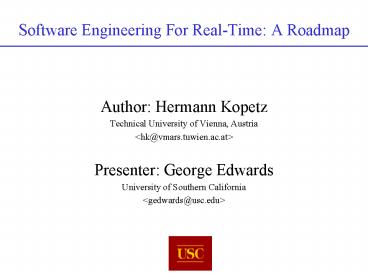Software Engineering For RealTime: A Roadmap PowerPoint PPT Presentation
1 / 14
Title: Software Engineering For RealTime: A Roadmap
1
Software Engineering For Real-Time A Roadmap
- Author Hermann Kopetz
- Technical University of Vienna, Austria
- lthk_at_vmars.tuwien.ac.atgt
- Presenter George Edwards
- University of Southern California
- ltgedwards_at_usc.edugt
2
Presentation Overview
- Introduction
- Technology Trends
- Requirements for Real-Time Systems
- Composability
- Validation
- Critique of the Paper
3
Introduction
- Increasingly widespread and important
- Avionics, telecommunications, medicine, and
defense applications - New challenges for software engineers
- Resource constraints
- Stringent quality-of-service (QoS) demands
- Availability, security, scalability
- Composability of COTS components
- Validation of component-based architectures
Distributed, Real-Time, Embedded (DRE) Systems
4
Technology Trends (1/2)
- Advances in the semiconductor industry will have
a strong influence on SE for RT - RT systems composed of two types of hardware
components - System-on-a-chip (SOC)
- High dependability, low-production costs
- Smart microelectronic mechanical systems (MEMS)
sensors - Signal conditioning, calibration, diagnostics,
and network control
5
Technology Trends (2/2)
- Economic factors demand that complex, large-scale
systems be composed of commercial-of-the-shelf
(COTS) components - A component is a self-contained subsystem used as
a building block in a larger system - Hardware components
- Software components
- Combined hardware/software components
- A self-contained SOC with OS and RT application
6
SE Requirements for DRE Systems (1/3)
- Two-level design methodology
- Strict separation of architectural design and
component development - Architectural level component interactions and
communication network interfaces - Component level implementation of defined
services - Requires precise specification of CNIs in both
value and temporal domains - Enables system analysis without knowing component
implementations
7
SE Requirements for DRE Systems (2/3)
- Predictable communication
- Two types of real-time networks
- System networks connect SOCs
- Sensor networks connect SOCs to smart sensors
- Both network types must
- Have stable temporal properties
- Provide a global time of known precision
8
SE Requirements for DRE Systems (3/3)
- Generic fault-tolerance
- Architectures that provide generic services
- Achieved through distributed communication
control and replication - Provided by the network, hardware, and system
software - Application software for fault-tolerant and
non-fault-tolerant systems is the same
9
Composability
- Components must be autonomous and encapsulated
- Various possible vantage points
- Service provision
- Validation
- Error containment
- Reuse
- Design and maintenance
- Design methodology must ensure these properties
are not invalidated by system integration.
10
Service Classes
- Analysis of component-based architectures should
distinguish - Prior services, provided by an individual
component - Emerging services, provided by integration of
multiple components
11
Component Interfaces
- Real-time Service (RS) interface
- Hides component implementation
- Provides a service according to the CNI spec
- Diagnostic and Management (DM) interface
- Exposes component implementation
- Allows configuration and fault diagnosis
- Configuration Planning (CP) interface
- Generates glue code
12
Principles of Composability
- Independent development of components
- System architecture does not rely on specific
component implementations, only interfaces - Stability of prior services
- Validated services not affected by integration
- Constructive integration
- Introduction of a new component does not
interfere with correct system operation
13
Validation
- Composable architectures will shift emphasis back
to product validation - Component designers will need to establish tight
upper bounds for all time-critical processes - Rare-event simulations (faults, peak-load
performance) will be required - Formal verification methods will grow in
importance
14
Critique of the Paper
- Strengths
- In depth analysis of composability and validation
- Very specific view of the future of RT systems
- Weaknesses
- Somewhat narrow focus ignores many important
issues - As much about hardware as software
- Relevance to embedded systems
- Embedded systems are almost always RT systems

